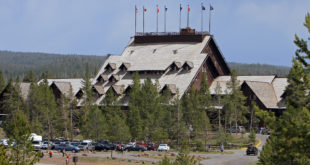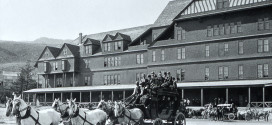Everyone is familiar with ghost towns. They’re places where people used to live but left for some reason, usually financial reasons. What are left are the buildings. Sometimes they’re well preserved, other times they are fragile shells falling apart on each other. In the case of Cinnabar, Montana, there’s nothing left. Were you to go visit the site, which is on a dirt road a few miles north of Gardiner on the west bank of the Yellowstone River (today within the boundaries of the Park), you may not recognize that it was once a town, and once Yellowstone’s first gateway town.
Cinnabar’s history is simple enough. A man named Bart Henderson originally owned the land in 1871, but the Nez Perce forced him off the land by burning down his ranch in 1877. Clarence Stephens purchased the James Henderson (Bart’s brother and neighbor) ranch and subsequently sold it to George Huston and Joe Keeny, who subsequently sold it to the North Pacific Railroad Company. The NPRC wanted to establish a railroad route to Yellowstone National Park to profit off of tourists heading for Yellowstone National Park. Unfortunately, they couldn’t get to Gardiner because of disputed with Robert Cutler, who claimed the land surrounding Gardiner and was too stubborn to give it up. So the next best thing was to set up the depot about three miles outside of Gardiner, which was where Cinnabar sprung up. Hugo Hoppe, a successful freighter, founded Cinnabar.
Being the last stop and closest to the park via railroad, Cinnabar became a successful little town. Tourists would get off there and take stagecoaches to the Park’s North Entrance. There were stores, a post office, as well as the Cinnabar Hotel. Cinnabar was so successful that when President Theodore Roosevelt came to visit, the Hotel was converted to a temporary White House. Obviously, this was not to last. Cinnabar’s only reason to exist was the railroad, so everyone knew the end was coming when the NPRC was finally able to extend the line to Gardiner in 1902.
Cinnabar was devastated by the extension of the line. The changes were so significant that on May 3, 1903, Cinnabar was no longer a rail stop. The post office closed on June 15th, 1903, and the depot was loaded onto a train and shipped to Gardiner. No one would revisit Cinnabar again for over a century.
Fast forward to summer of 2007. The assistant professor of archeology at the University of Montana at Missoula, Douglas Macdonald, sets out with a group of 13 students to find Cinnabar. “People generally knew where Cinnabar was,” Doug said over the phone. “There were eleven depressions in the ground where buildings stood, and we compared the depressions with old photos to confirm Cinnabar’s location.” Over the course of that summer and this summer with a group of 16, Macdonald and his group started uncovering various artifacts pertaining to both Cinnabar’s history and how Native Americans used the land before the pioneers. In fact, several Native Americans participated on the dig, including UM graduate student and Ojibway Robert Peltier. His goal was to discover how Native Americans “used the whole landscape.” So far, with the discovery of winter teepees and bighorn sheep traps, it looks like they not only knew the environment, but they knew how to use it effectively.
The rediscovery of Cinnabar “adds a great bit of information to the park history,” said Elaine Hale, an archeologist in Yellowstone, to the Bozeman Daily Chronicle. “Before these guys came, we had no money to do this. The project was just too huge.”
One of the highlights of the dig is a five-foot mortar and cobble wall that is the foundation of the Cinnabar Hotel, run by Hugo Hoppe. They’ve also found an old blacksmith shop and a store near the hotel. In an old outhouse on the site, members of the field school have found alcoholic beverage bottles, a girdle cinch, a suspender clip, and a stopper from a vial of holy water. You can see for yourself, since the site is open for visitation. If you do some orderly digging, you can find wood floors under the dirt. That is, if you can get through the shattered pottery, bed springs, nails, and sardine cans scattered on the ground. But don’t be tempted to take home a souvenir. “You can’t take anything away, or you’ll be fined $1,100,” said Douglas Macdonald, essentially making that the most expensive can of sardines ever.
So, what does this dig mean for Cinnabar’s future? What is to become of the site of Yellowstone’s first gateway community? Will a museum be built to house all that they’ve found? Will a recreation of the town be created, like how Williamsburg, Virginia was restored? Will this seemingly empty plot of land be listed in the National Register of Historic Places? No. When the field school is complete, the excavations will be marked and buried, and the Park Service will reseed the area to aid the antelope population.
So is that it? Of course not. There’s just nothing left to do. When the area that was once Cinnabar is replanted with natural, native vegetation, its history will come full circle.
Most ghost towns are abandoned and subsequently stand for years as empty shells, or are rediscovered and restored for curious eyes. In the case of Cinnabar, there are only indents where buildings stood and remains of human development. There are and will be no physical remains, save the relics found on site. That makes Cinnabar more of a ghost town than any normal ghost town. Not only are there no more people living in Cinnabar, there isn’t even a Cinnabar left to go to! Much like a ghost, Cinnabar has transcended the material world, only to come back as part of Yellowstone National Park’s history. Cinnabar was and will always be Yellowstone National Park’s first gateway community, even though there is no more trace of it. That is more than any town could ask for.
 Yellowstone Insider Your Complete Guide to America's First National Park
Yellowstone Insider Your Complete Guide to America's First National Park





